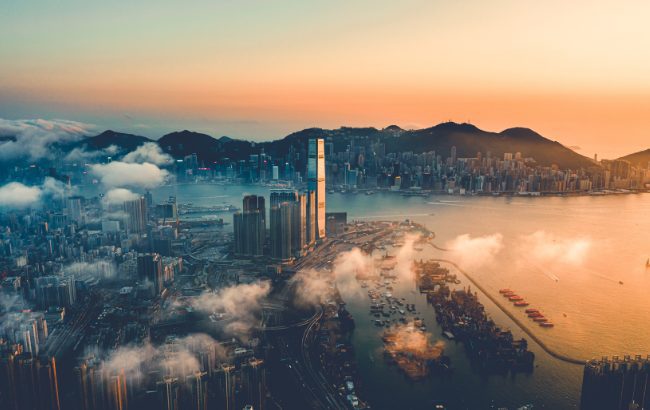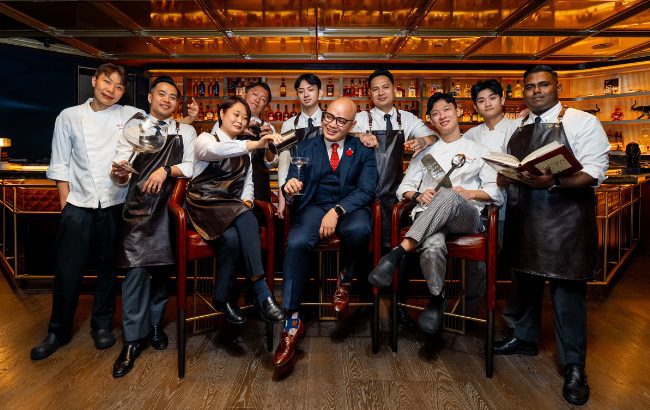Global Bar Report 2025: Asia
By Melita KielyBars in Asia are outshining restaurants by adding exciting food choices to go along with their drinks offerings.

*This feature was originally published in the November 2025 issue of The Spirits Business magazine.
There’s a convergence of food and drink developing in Asia. Bars are no longer just a precursor to dinner plans; they are becoming the main event. Food menus and bar snacks are being taken just as seriously as the cocktails they’re served alongside, giving added incentives for consumers to stay.
“You can see bars being more intentional about offering an even more well‐rounded experience for the guests,” says Angel Chiu, who co‐founded Sugar King in Hong Kong this year with John Nugent.
“It’s no longer just a focus on drinks, but also on food and collaborative experiences with many different other fields like fashion, restaurants, and sports. We are truly entering all facets of lifestyle.”
Bar Leone, Hong Kong’s Italian‐inspired neighbourhood drinking den that was crowned ‘world’s best bar’ by 50 Best this year, has not only made a name for itself with its masterful ‘cocktail popolari’ (cocktails for the people) approach, but also its mouth‐ watering food. Think focaccia laden with ribbons of mortadella, ricotta, and pickled chillies, and smoked olives – perfect for grazing during drawn‐out evenings.
“The scene in Hong Kong is constantly evolving,” says Lorenzo Antinori, founder of Bar Leone. “Lately, bars have been doing better than restaurants overall, and this has incentivised investment in that direction, with new quality concepts, which at the same time are very approachable. We see that trend in China as well, and that was one of the reasons that brought us to Shanghai,” he adds, referencing the recent opening of his second outpost in the Chinese city.
In Japan, tourism has seen a huge spike recently. According to the Japan National Tourism Organization, the estimated number of international travellers to the country in August 2025 was 3,428,00 – a 16.9% increase on August 2024. Holly Graham, founder and creative director of Tokyo Confidential, and creative director of Japan’s Niseko Confidential and Tepache, notes: “Cities outside of Tokyo are getting recognition as tourism increases in Japan due to the attractive exchange rate. An increase in tourism increases business and encourages adaptability. If this level of tourism continues, I think we’ll see a lot more bars catering for international guests opening.”
It makes sense, then, that international hotel bars in Japan appear to be upping their game. “The amazing Virtù has always been the ‘flagship’ hotel bar for Tokyo, but I’m seeing an increase of new hotels hiring international staff – or unashamedly trying to poach mine,” Graham quips.
In Singapore, however, while the country remains home to some of Asia’s most forward‐thinking bars, it has been a tough year. At the start of 2025, Tippling Club became the first of several bars to shut, followed by queer venues Tuckshop and Sausage Market. In March, Smoke & Mirrors at the National Gallery closed, and in July, the Jigger & Pony group shut two of its venues, although a replacement opened last month.
Perfect storm
A perfect storm of challenges has been building in Singapore, as Christina Rasmussen, co‐owner of Fura in the country, touches on. “In general, the cost of everything has gone up, whether it’s produce, spirits, salaries. Probably the most problematic is the rent,” Rasmussen says. “There’s no rent control here, and properties are mixed, owned by both corporations and privately, so there’s very little regulation. There used to be a rent‐control act, which was abolished in 2001; it was more so driven towards housing than business, as Singapore took further steps towards a ‘free market’, but regardless, it has been done and can be updated, and implemented again.
Another big issue tied to that is the only types of businesses that can afford these costs are larger chains and foreign brands with lots of resources, so now as small owners we’re competing with these types of companies who can afford inflated salaries and expensive rent.”
Jesse Vida, founding partner of Singapore’s Cat Bite Club agrees. He also notes the increase in domestic rent, meaning consumers have less disposable income, which is reflected in hospitality’s footfall. However: “This seems to be stabilising recently, so we’re hopeful for the year ahead,” he adds.
Some of the key trends Vida is seeing in bars include vegetal, savoury, and umami‐ flavoured cocktails – and not just in Singapore, but in greater Asia as well. “At Cat Bite Club, we’ve had a few unique vegetal‐forward cocktails recently, including our Hulk Splash (Ocho Blanco Tequila, kiwi, citrus blend, Fernet Hunter Granit, and roasted broccoli) and Sippin’ Shrooms (pisco, Hachi Kokuto, shiitake‐infused Sherry, umeshu, sesame, amaro, and celery bitters), which have been popular.”
Looking to the year ahead, and Bar Leone’s Antinori shares his outlook: “We will keep seeing the rise of emerging markets such as Indonesia, Vietnam, and India, while hoping for some other major industry activities in our region, which will bring more travellers and awareness.”
Read the Global Bar Report overview and region reports on Europe, North America and South America here.
Bars to watch in 2026
Sugar King, Hong Kong

Earlier this year, John Nugent – founder of the The Diplomat, the first bar in Hong Kong to be recognised by The Pinnacle Guide – and industry expert Angel Chiu joined forces to open Sugar King. Taking inspiration from bodeguitas, the vibey bars that populate Havana in Cuba, it’s standing room only, but is well worth a visit. The menu rotates daily, but expect riffs on Old Fashioneds, Cuba Libres, Daiquiris, and more. With Nugent and Chiu at the helm, you know that this is going to be a much talked‐about drinking den in 2026.
Penicillin, Shanghai, China

The Hong Kong edition of the bar is renowned for creating some of the city’s best cocktails. Plus, it boasts an impressive commitment to sustainability. Imbibers in Shanghai can now also experience the magic of Penicillin, as the bar opened its Chinese outpost this year. The closed‐loop concept has a unique contemporary feel, with a bottled‐lined bar, repurposed neon lights and a tree hanging from the ceiling. The drinks are mind‐blowingly creative, utilising the bar’s lab, fermentation room, kitchen and bar to recycle and upcycle ingredients, yet they are still extremely quaffable.
Horatio, Singapore

Inspired by a fictional globetrotter, what makes Horatio special is the bar’s whisky offering. The whisky‐focused venue took inspiration from the journeys of Horatio Fairchild, a fictional character who has visited the world’s greatest distilling locations. Inside, there is a trio of distinct spaces: The Main Parlour, The Retail Emporium, and The Enclave (an invitation‐ only room). Once at your seat, the back bar features more than 300 rare whiskies, including The Macallan Reach 81 Years Old, Karuizawa Omoiyari 36 Years Old, and Port Ellen 1978 43 Years Old.
Related news
UK licensing reform gets lukewarm response from on-trade
